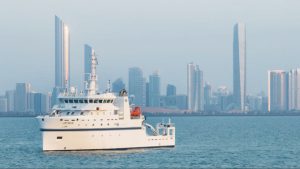ABU DHABI / WAM
The Environment Agency – Abu Dhabi (EAD) announced that it has successfully completed the first ever Atmospheric Research Expedition in the Arabian Gulf onboard its state-of-the-art marine research vessel — Jaywun.
The agency was the first organisation in the world to conduct atmospheric research from Spain to Abu Dhabi, which covered 25 countries and eight seas and oceans on a journey of more than 10,000 km from December 2022 to January 2023, also onboard Jaywun.
The pioneering Atmospheric Research Expedition in the Arabian Gulf undertook a comprehensive examination of the transportation and the subsequent transformation of hydrocarbons and nitrogen oxides. The campaign also sought to assess how pollution from the Arabian Gulf is transported to other regions and to evaluate its contribution to the formation of ozone in the UAE.
The expedition was a collaboration between EAD and the Climate and Atmosphere Research Center (CARE-C) of The Cyprus Institute from Cyprus and the Max Planck Institute for Chemistry from Germany. In addition, the project received assistance from scientists from the University of Bremen in Germany and the Climate and Environment Sciences Laboratory in France. The King Abdullah University of Science and Technology (KAUST) in Saudi Arabia will also be involved when the project reaches the model simulation stage.
Faisal Hammadi, Executive Director of Environmental Quality Sector, said, “Following our extremely successful Atmospheric Research Expedition from Vigo in Spain to Abu Dhabi in the UAE to measure air quality, we have now completed the first ever atmospheric research expedition in the Arabian Gulf using the new EAD research vessel Jaywun. Gathered by a multinational team, the results will be available in 2024 and serve several purposes.”
“From a scientific perspective, they will enhance our understanding of ozone formation in the region and improve atmospheric models. By unravelling the dynamics of ozone formation and its connections to regional sources in this understudied area, policymakers will have a better foundation for implementing effective measures to control and regulate emissions, thereby addressing concerns related to ozone.”
He added, “The research and data obtained from this expedition will also benefit Abu Dhabi in several ways. Firstly, Abu Dhabi experiences high levels of ozone, and this study will help determine the extent to which this pollution is transported within the emirate. By understanding these transport patterns, policymakers and authorities can develop targeted mitigation measures to alleviate the impact of ozone on the local environment and public health.
Furthermore, the data collected will be combined with the existing extensive atmospheric monitoring network established across Abu Dhabi. This integration will provide a more comprehensive and detailed understanding of the region’s ozone levels and air quality. This enhanced understanding will enable authorities to make informed decisions, implement effective strategies, and take necessary actions to improve air quality and safeguard the well-being of residents in Abu Dhabi.”
Under the patronage of H.H. Sheikh Hamdan bin Zayed Al Nahyan, Ruler’s Representative in Al Dhafra Region and Chairman of EAD, the Agency built the Middle East’s most advanced research vessel, Jaywun.
The 50-meters state-of-the-art, multipurpose marine conservation and fisheries vessel uses environment-friendly technologies to conduct specialised research in the Arabian Gulf – the world’s hottest sea and a natural climate change laboratory – as part of the UAE’s forward-looking science and innovation-based initiatives.
EAD undertook the atmospheric research from Spain to Abu Dhabi as a result of a Memorandum of Understanding (MoU) with the Max Planck Society – Germany’s most successful research organisation, which has produced 30 Nobel Prize winners, including Albert Einstein, and publishes more than 15,000 papers each year – and The Cyprus Institute, a regional hub for air pollution and climate change research that seeks sustainable solutions factoring in the societal challenges of the Eastern Mediterranean and Middle East region.
Atmospheric monitoring was conducted across eight major bodies of water: Atlantic Ocean, Mediterranean Sea, Gulf of Suez, Red Sea, Gulf of Aden, Arabian Sea, Sea of Oman, and Arabian Gulf, and covered three continents: Europe, Africa, and Asia.
The agreement saw the EAD research vessel fitted with advanced monitoring equipment supplied and operated by researchers of the Climate and Atmosphere Research Center (CARE-C) of The Cyprus Institute, a leading regional Centre of Excellence for air pollution and climate change research, and the Max Planck Institute for Chemistry, a leading research institute focusing on chemical processes in the Earth system.
More than 22 parameters were monitored, including air quality regulated parameters, greenhouse gas concentrations, volatile organic compounds and aerosol properties. “By differentiating between the unique range of locations downwind of continental emissions, the researchers will be able to determine the human influence on the marine environment”, said Professor Jos Lelieveld, Managing Director of the Max Planck Institute.
“These two expeditions are setting up the foundation for long-term atmospheric observations in the Gulf region which will provide a better understanding of the interlinks between atmospheric composition, air pollution and climate change. They pave the road towards the development of highly competitive atmospheric research infrastructures that will be key to further build capacity and promote regional scientific collaborations,” said Professor Jean Sciare, Director of the Climate and Atmosphere Research Centre (CARE-C) of the Cyprus Institute.
The results of the atmospheric research from Spain to Abu Dhabi and the Atmospheric Research Expedition in the Arabian Gulf will be vital to understanding air quality and help develop policies and mitigation plans for a safer environment for all.
 The Gulf Time Newspaper One of the finest business newspapers in the UAE brought to you by our professional writers and editors.
The Gulf Time Newspaper One of the finest business newspapers in the UAE brought to you by our professional writers and editors.
